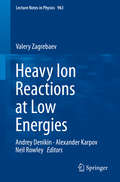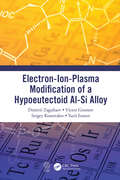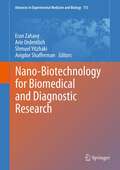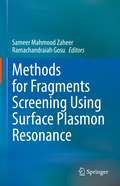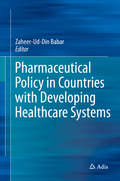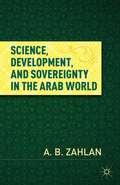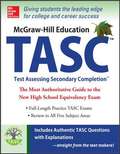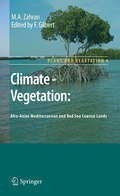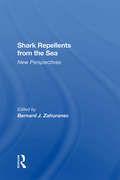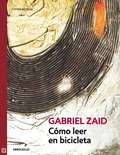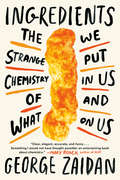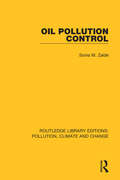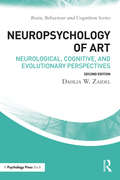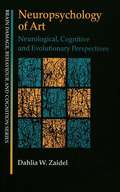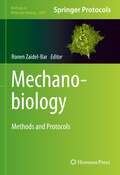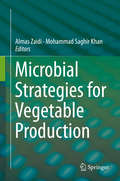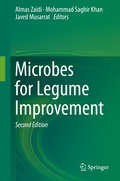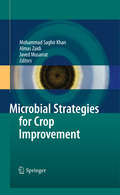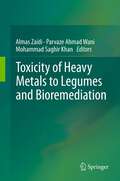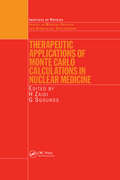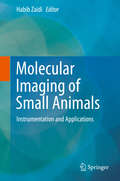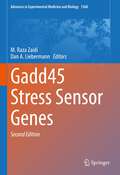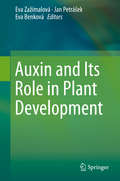- Table View
- List View
Heavy Ion Reactions at Low Energies (Lecture Notes in Physics #963)
by Valery ZagrebaevThis book is based on Valery Zagrebaev's original papers and lecture materials on nuclear physics with heavy ions, which he prepared and extended through many years for the students of nuclear physics specialties.Thе book outlines the main experimental facts on nuclear reactions involving heavy ions at low energies. It focuses on discussions of nuclear physics processes that are a subject of active, modern research and it gives illustrative explanations of these phenomena in the framework of up-to-date theoretical concepts.This textbook is intended for students in physics who have completed a standard course of quantum mechanics and have basic ideas of nuclear physics processes.It is designed as a kind of lifeboat that, at the end of the course, will allow students to navigate the modern scientific literature and to understand the goals and objectives of current, on-going research.
Electron-Ion-Plasma Modification of a Hypoeutectoid Al-Si Alloy
by Dmitrii Zaguliaev Victor Gromov Sergey Konovalov Yurii IvanovElectron-Ion-Plasma Modification of a Hypereutectic Al-Si Alloy details theoretical and experimental research and computer simulation of structural phase transformations in AlSi10Mn2Ni Silumin on different scale levels under electroexplosion alloying, electron beam processing and electron-plasma alloying at the nanolevel in order to create new materials. The authors summarize and analyze more than 10 years of research on the electron-ion-plasma effect on strength properties and structure-phase states’ transformations of hypoeutectic Silumin. Key Features: Details physical and mathematical models of mechanisms of surface layer hardening under conditions of varying energy effects Offers insights into improved strength characteristics of Silumin Explores optimal processing modes for increased strength and improved tribological characteristics This book is a valuable resource to researchers and engineers involved with the modification of light alloy surfaces for the automotive and aeronautical industry.
IUTAM Symposium on Intelligent Multibody Systems – Dynamics, Control, Simulation (Iutam Bookseries #33)
by Evtim Zahariev Javier CuadradoThis volume, which brings together research presented at the IUTAM Symposium Intelligent Multibody Systems – Dynamics, Control, Simulation, held at Sozopol, Bulgaria, September 11-15, 2017, focuses on preliminary virtual simulation of the dynamics of motion, and analysis of loading of the devices and of their behaviour caused by the working conditions and natural phenomena. This requires up-to-date methods for dynamics analysis and simulation, novel methods for numerical solution of ODE and DAE, real-time simulation, passive, semi-passive and active control algorithms. <p><p> Applied examples are mechatronic (intelligent) multibody systems, autonomous vehicles, space structures, structures exposed to external and seismic excitations, large flexible structures and wind generators, robots and bio-robots.
Nano-Biotechnology for Biomedical and Diagnostic Research
by Eran Zahavy Arie Ordentlich Shmuel Yitzhaki Avigdor ShaffermanThe title "Nano Biotechnology for Biomedical and Diagnostics Research" will address research aspects related to nanomaterial in imaging and biological research, nanomaterials as a biosensing tool, DNA nanotechnology, nanomaterials for drug delivery, medicinal and therapeutic application and cytotoxicity of nanomaterials. These topics will be covered by 16 different manuscripts. Amongst the authors that will contribute to the book are major scientific leaders such as S. Weiss - UCLA, I. Willner, and G. Golomb - HUJI, S. Esener - UCSD, E.C. Simmel - Tech. Univ. Munchen, I. Medintz - NRL, N. Hildebrandt - Université Paris and more. The manuscripts in the book intend to present specifically biological, diagnostics and medical problems with their potential solution by nano technology or materials. In this respect this book is unique, since it would arise from the biological problems to the nano technology possible solution and not vice versa.
Methods for Fragments Screening Using Surface Plasmon Resonance
by Sameer Mahmood Zaheer Ramachandraiah GosuThis volume describes methods and protocols for the fragment-based screening of proteins using Surface Plasmon Resonance (SPR). The initial chapter of the book discusses the principle of SPR for the identification of biomolecular interactions, while the subsequent chapters introduce methods for labelling proteins with different tags including, histidine and biotin tags. It also discusses techniques and factors that affect the amine and biotin-streptavidin coupling and methods to optimize the interactions. Next, it describes fragment preparation for screening in SPR and presents methods to calculate equilibrium dissociation constant (KD) and ligand efficiency (LE). It reviews techniques of next-generation injections that improve the efficiency of the characterization process over traditional SPR by determining the kinetics and affinity in a single step. Finally, the book elucidates a comprehensive yet representative description of challenges associated with the molecular interaction of proteins using SPR.
Pharmaceutical Policy in Countries with Developing Healthcare Systems
by Zaheer-Ud-Din BabarA comprehensive and granular insight into the challenges of promoting rational medicine, this book serves as an essential resource for health policy makers and researchers interested in national medicines policies. Country-specific chapters have a common format, beginning with an overview of the health system and regulatory and policy environments, before discussing the difficulties in maintaining a medicines supply system, challenges in ensuring access to affordable medicines and issues impacting on rational medicine use. Numerous case studies are also used to highlight key issues and each chapter concludes with country-specific solutions to the issues raised. Written by highly regarded academics, the book includes countries in Africa, Asia, Europe, the Middle East and South America.
Science, Development, and Sovereignty in the Arab World
by A. B. ZahlanZahlan's detailed study examines recent and current performance of Arab countries and their organizations in scientific research in relation to their socio-economic development. It shows that the Arab countries are severely handicapped by a political economy dominated by technological dependence, corruption, and limited research collaboration.
McGraw-Hill Education TASC - Test Accessing Secondary Completion
by Kathy A. ZahlerIt's packed with everything you need to succeed on the test---and get the high school credential you want. Only this guide can show you exactly what to expect on the test, tell you how the test is scored, and give you authentic TASC questions for practice. That makes this bestselling guide your most reliable and accurate source for everything you need to know about the TASC.
Climate - Vegetation: Afro-Asian Mediterranean and Red Sea Coastal Lands (Plant and Vegetation #4)
by M. A. Zahran Francis GilbertDeserts are unique ecosystems with their own biotic and abiotic components, and are often rich in renewable natural resources, the appropriate management of which can contribute significantly to the sustainable management of desert regions for the welfare of the people. Yet while there are many books on the flora of the countries fringing the important desert countries of the Mediterranean and Red Seas, there or few books reporting on their ecophysiology and vegetation ecology. This book presents the vegetation types of the African and Asian countries of the Mediterranean and Red Sea coastal regions, and discusses the ecological threats and economic applications of these critical resources. In particular, it examines the relationships between climate and vegetation, and discusses these within the context of desertification, agro-industrial applications, ecotourism and sustainable development. The book will provide a valuable reference for researchers and graduate students involved in plant ecology, biogeography, economic botany and environmental management in the Afro-Asian Mediterranean and Red Sea coastal regions, as well as other desert regions around the world.
Shark Repellents From The Sea: New Perspectives
by Bernard J ZahuranecSome species of sharks, because they are large, agile predators, are extremely dangerous to humans in water. During World War II, the long-time goal of an effective shark repellent was partially realized by the U.S. Navy's development of "Shark Chaser," a copper acetate-negrosine dye mixture. But neither Shark Chaser nor other noxious or even extre
Como leer en bicicleta
by Gabriel ZaidEste es un libro alegre, juguetón, por momentos soberbiamente irresponsable, que tiene la capacidad, más bien infrecuente en la literatura de nuestros días, de excitar la inteligencia y provocar carcajadas al mismo tiempo. Zaid ha conseguido sortear los lugares comunes del artículo cultural corriente, y sus ensayos son sistemáticamente anticonvencionales. Otra virtud que tiene el uso irresponsable (es decir, lúdico) del saber científico en materia de literatura (aparte de producir textos brillantes y divertidos) es que proporciona una especie de alivio. A quienes creen que en esta era de computadoras y robots inteligentísimos la literatura puede desaparecer como quehacer humano al recibir el impacto de la ciencia, los ensayos de Zaid les demuestran que no hay nada que temer. Si la colisión se produce, al menos en este caso, es el supuesto Frankenstein el que se desintegra al tocar la mariposa, es la ciencia la que se vuelve poesía. Mario Vargas Llosa
Ingredients: The Strange Chemistry of What We Put in Us and on Us
by George ZaidanCheese puffs. Coffee. Sunscreen. Vapes. George Zaidan reveals what will kill you, what won&’t, and why—explained with high-octane hilarity, hysterical hijinks, and other things that don&’t begin with the letter H. INGREDIENTS offers the perspective of a chemist on the stuff we eat, drink, inhale, and smear on ourselves. Apart from the burning question of whether you should eat that Cheeto, Zaidan explores a range of topics. Here&’s a helpful guide: Stuff in this book:- How bad is processed food? How sure are we?- Is sunscreen safe? Should you use it?- Is coffee good or bad for you?- What&’s your disease horoscope?- What is that public pool smell made of?- What happens when you overdose on fentanyl in the sun?- What do cassava plants and Soviet spies have in common?- When will you die?Stuff in other books:- Your carbon footprint- Food sustainability- GMOs- CEO pay- Science funding- Politics- Football- Baseball- Any kind of ball really Zaidan, an MIT-trained chemist who cohosted CNBC&’s hit Make Me a Millionaire Inventor and wrote and voiced several TED-Ed viral videos, makes chemistry more fun than Hogwarts as he reveals exactly what science can (and can&’t) tell us about the packaged ingredients sold to us every day. Sugar, spinach, formaldehyde, cyanide, the ingredients of life and death, and how we know if something is good or bad for us—as well as the genius of aphids and their butts—are all discussed in exquisite detail at breakneck speed.
Oil Pollution Control
by Sonia M. ZaideOil pollution has been a major environmental concern since the 1920s. The search for a solution has ranged from prevention to partial measures coupled with compensation and remedial action. This book, originally published in 1987, offers a different assessment of the efforts of governments and the oil and maritime industries. It was also the first book to provide a comprehensive story of control policies and practices, using primary and secondary sources. The book identified numerous factor – personalities, state policies, developments in the oil and shipping industries, public agitation and scientific studies in a framework useful for analysing any environmental problem.
Neuropsychology of Art: Neurological, Cognitive, and Evolutionary Perspectives (Brain, Behaviour and Cognition)
by Dahlia W. ZaidelFully updated, the second edition of Neuropsychology of Art offers a fascinating exploration of the brain regions and neuronal systems which support artistic creativity, talent and appreciation. This landmark book is the first to draw upon neurological, evolutionary, and cognitive perspectives, and to provide an extensive compilation of neurological case studies of professional painters, composers and musicians. The book presents evidence from the latest brain research, and develops a multidisciplinary approach, drawing upon theories of brain evolution, biology of art, art trends, archaeology, and anthropology. It considers the consequences of brain damage to the creation of art and the brain’s control of art. The author delves into a variety of neurological conditions in established artists, including unilateral stroke, dementia, Alzheimer’s Disease, Parkinson’s Disease, and also evidence from savants with autism. Written by a leading neuropsychologist, Neuropsychology of Art will be of great interest to students and researchers in neuropsychology, cognitive psychology, neuroscience, and neurology, and also to clinicians in art therapy.
Neuropsychology of Art: Neurological, Cognitive and Evolutionary Perspectives (Brain, Behaviour and Cognition)
by Dahlia W. ZaidelThe significance of art in human existence has long been a source of puzzlement, fascination, and mystery. In Neuropsychology of Art, Dahlia W. Zaidel explores the brain regions and neuronal systems that support artistic creativity, talent, and appreciation.Both the visual and musical arts are discussed against a neurological background. Evidence from the latest relevant brain research is presented and critically examined in an attempt to clarify the brain-art relationship, language processing and visuo-spatial perception. The consequences of perceptual problems in famous artists, along with data from autistic savants and established artists with brain damage as a result of unilateral stroke, dementia, or other neurological conditions, are brought into consideration and the effects of damage to specific regions of the brain explored. A major compilation of rare cases of artists with brain damage is provided and the cognitive abilities required for the neuropsychology of art reviewed.This book draws on interdisciplinary principles from the biology of art, brain evolution, anthropology, and the cinema through to the question of beauty, language, perception, and hemispheric specialization. It will be of interest to advanced students in neuro-psychology, neuroscience and neurology, to clinicians and all researchers and scholars interested in the workings of the human brain.
Mechanobiology: Methods and Protocols (Methods in Molecular Biology #2600)
by Ronen Zaidel-BarThis detailed book collects methodologies exploring mechanobiology, the involvement of mechanical forces in cell fate specification and in controlling single and collective cell behaviors such as directed migration, morphogenesis, wound healing, and the immune response. The volume features methods to quantify the mechanical properties of cells and adhesion proteins, to expose cells to external mechanical forces, to quantitatively characterize mechano-responses at various scales, to measure forces applied by cells on the extracellular matrix, as well as chapters on force measurement inside cells, probing cell signaling and gene expression in response to force, and biophysical modeling of cell shape and protein dynamics. Written for the highly successful Methods in Molecular Biology series, chapters include introductions to their respective topics, lists of the necessary material and reagents, step-by-step and readily reproducible protocols, and tips on troubleshooting and avoiding known pitfalls. Authoritative and practical, Mechanobiology: Methods and Protocols aims to provide meaningful tools for cell and developmental biologists approaching the study of cell and tissue dynamics from a mechanobiological perspective, molecular biologists interested in the effects of force on proteins, as well as for cancer biologists and biophysicists.
Microbial Strategies for Vegetable Production
by Almas Zaidi Mohammad Saghir KhanThis book provides a comprehensive information on basic and applied concepts of microbesial strategies adopted for the improvement of vegetables grown in various production systems. The beneficial role of soil microbes including plant growth promoting rhizobacteria (PGPR), nitrogen fixers, and phosphate-solubilizing bacteria in the improvement of vegetables grown both in normal and contaminated soils is discussed. The role of PGPR in tomato production is dealt separately. The impact of heavy metals on different vegetables and abatement of metal toxicity following metal tolerant PGPR and their consequential impact on vegetables grown in metal polluted soil is discussed. Moreover, recent advances in the management of vegetable diseases employing PGPR are addressed. This volume is therefore of special interest to both academics, professionals and practitioners working in the field of vegetable farming/horticulture, microbiology and plant protection sciences.
Microbes for Legume Improvement
by Almas Zaidi Mohammad Saghir Khan Javed MusarratMicrobes for Legume Improvement comprises 21 chapters and provides comprehensive information on concepts of microbial technology for the improvement of legumes grown in different agro-ecosystems. The role of microbes including symbiotic nitrogen fixers, asymbiotic nitrogen fixing bacteria (like Azospirillum), plant growth promoting rhizobacteria (PGPR), phosphate-solubilizing microbes, arbuscular mycorrhizal fungi and biocontrol agents in the improvement of both conventional and forage legumes growth is discussed. The role of bacterial biofilms in legume-Rhizobium interactions and metal tolerant microbes in the improvement of legumes is dealt separately. Furthermore, recent findings on the taxonomic status of rhizobia, various signal molecules affecting symbiosis, legume-pathogen and legume-rhizobial interactions and proteomic analysis of legume-microbe interactions are addressed. This volume gives a broad view of legume disease management using microbes and presents strategies for the management of cultivated legumes. It is therefore of special interest to both academics and professionals working in the field of microbiology, soil microbiology, environment microbiology, biotechnology and agronomy as well as plant protection sciences.
Microbial Strategies for Crop Improvement
by Almas Zaidi Mohammad Saghir Khan Javed MusarratThis book presents the multidisciplinary nature and the many fascinating aspects of microbiological approaches for crop improvement in both conventional and stressed soils where quality and safety are the key concerns. The major goal is to provide a cross-section of the latest accomplishments and envisaged future directions in these areas. It gives a holistic view of the basic concepts and practical utility of microbes and thus presents an all-inclusive contemporary treatise on strategic aspects of the diverse microbial communities providing solutions to oodles of customary agronomic problems. This book benefits people working in the area of agronomy, biotechnology, environmental biology, microbiology, plant physiology, plant protection and soil science. The contributions by eminent academicians and professionals ensure a good equilibrium between theory and practice without compromising the basic conceptual framework of the concerned subject.
Toxicity of Heavy Metals to Legumes and Bioremediation
by Almas Zaidi Parvaze Ahmad Wani Mohammad Saghir KhanThis title discusses various effects of heavy metal exposure to legumes as well as the bioremediation potential of rhizosphere microbes. Availability of heavy metals, their uptake and the effects of metals on various signaling pathways within legumes are presented. Furthermore, the effects of heavy metals to nitrogen fixing microorganisms and how microsymbionts can overcome metal stress is presented in detail. The role of nitrogen fixers in decontamination of heavy metal toxicity, mycoremediation of metal contaminated soils, microbially mediated transformation of heavy metals and action of plant growth promoting rhizobacteria and nitrogen fixers together in detoxifying heavy metals are broadly explained. This volume is a useful tool for scientists, policy makers and progressive legume growers intending to develop safe and healthy legumes for future generations.
Therapeutic Applications of Monte Carlo Calculations in Nuclear Medicine (Series in Medical Physics and Biomedical Engineering)
by H. Zaidi G. SgourosTherapeutic Applications of Monte Carlo Calculations in Nuclear Medicine examines the applications of Monte Carlo (MC) calculations in therapeutic nuclear medicine, from basic principles to computer implementations of software packages and their applications in radiation dosimetry and treatment planning. With chapters written by recognized authorit
Molecular Imaging of Small Animals
by Habib ZaidiThis book examines the fundamental concepts of multimodality small-animal molecular imaging technologies and their numerous applications in biomedical research. Driven primarily by the widespread availability of various small-animal models of human diseases replicating accurately biological and biochemical processes in vivo, this is a relatively new yet rapidly expanding field that has excellent potential to become a powerful tool in biomedical research and drug development. In addition to being a powerful clinical tool, a number of imaging modalities including but not limited to CT, MRI, SPECT and PET are also used in small laboratory animal research to visualize and track certain molecular processes associated with diseases such as cancer, heart disease and neurological disorders in living small animal models of disease. In vivo small-animal imaging is playing a pivotal role in the scientific research paradigm enabling to understand human molecular biology and pathophysiology using, for instance, genetically engineered mice with spontaneous diseases that closely mimic human diseases.
Gadd45 Stress Sensor Genes (Advances in Experimental Medicine and Biology #1360)
by M. Raza Zaidi Dan A. LiebermannThis second edition is fully updated throughout and covers the emerging evidence that indicates that the Gadd45 family of proteins plays a unique and critical role as sensors of stress, including genotoxic, physiological, and oncogenic stress. It sheds light on the complex cellular stress response, encompassing myriad molecular pathways with a plethora of regulators and effectors.The GADD45 stress response genes encode small (18 kd) nuclear/cytoplasmic proteins. These genes are rapidly induced by a wide variety of endogenous and exogenous stress stimuli. Despite marked similarities, Gadd45 genes are regulated differentially and exhibit functional diversity. Gadd45 proteins respond to physiological and oncogenic stress, and are implicated in cell cycle arrest, DNA demethylation and repair, apoptosis, cell survival, genomic stability, and inflammation. The purpose of this book is to provide a comprehensive overview of the unique global role that Gadd45 proteins play as stress sensors and the molecular pathways involved.
Auxin and Its Role in Plant Development
by Eva Zažímalová Jan Petrášek Eva BenkováAuxin is an important signaling compound in plants and vital for plant development and growth. The present book, Auxin and its Role in Plant Development, provides the reader with detailed and comprehensive insight into the functioning of the molecule on the whole and specifically in plant development. In the first part, the functioning, metabolism and signaling pathways of auxin in plants are explained, the second part depicts the specific role of auxin in plant development and the third part describes the interaction and functioning of the signaling compound upon stimuli of the environment. Each chapter is written by international experts in the respective field and designed for scientists and researchers in plant biology, plant development and cell biology to summarize the recent progress in understanding the role of auxin and suggest future perspectives for auxin research.
Una gira por el sistema solar: Planetas, asteroides y exploración espacial: desde Mercurio hasta la nube de Oort
by Patricio ZainEn clave pop, metalera y queer, Patricio Zain, doctor en Astronomía, comparte en este libro las últimas novedades e información sobre planetas, asteroides, misiones espaciales y otros mundos, y explica por qué es importante que sepamos qué hay más allá de la Luna. ¿Cuánto dura un día en Mercurio? ¿Venus es un infierno? ¿Podremos vivir en Marte? ¿Júpiter nos protege de una lluvia de meteoritos o la provoca, como buen bully? ¿Por qué Saturno se parece a Beyoncé? ¿Plutón es un planeta o no? ¿Urano y Neptuno son helados gigantes? ¿Un asteroide puede destruir la Tierra en el corto plazo? ¿Hay vida en otros planetas? ¿Existen cuerpos no binarios en el espacio transneptuniano? Estas preguntas, y muchas otras, serán respondidas a lo largo de esta gira que recorre la diversidad de mundos del sistema solar, con innumerables guiños a Lady Gaga, Taylor Swift, Judas Priest y demás artistas legendarios. En clave pop, metalera y queer, Patricio Zain, doctor en Astronomía, comparte en este libro las últimas novedades del conocimiento aportado por esa ciencia y las misiones espaciales acerca de los planetas, los asteroides, los cometas, los satélites y los transneptunianos, y explica por qué es importante saber qué hay más allá de la Tierra.
